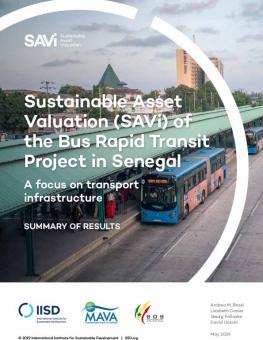
Sustainable Asset Valuation (SAVi) of the Bus Rapid Transit Project in Senegal
This report discusses the results of the SAVi analysis on the Bus Rapid Transit project in Dakar (Senegal).
Key Messages
- When taking account of externalities the Bus Rapid Transit (BRT) project in Dakar brings 2,191,656 million CFA total net benefits to the Senegalese society.
- The positive externalities of the BRT project are significant and make the project worthwhile.
This report discusses the results of the SAVi analysis on the Bus Rapid Transit project in Dakar (Senegal).
The public transportation project that is set up to improve mobility in and around Dakar expects to transfer 300,000 passengers per day.
The SAVi analysis takes the following externalities into account: additional income spent in the domestic economy because of the job creation related to the project, the value of time saved, avoided cost of transportation, avoided cost of pollution, avoided cost of GHG emissions and avoided costs of accidents. It simulates different scenarios based on the demand for public transportation with the BRT. The results demonstrate that the positive externalities of the BRT project are significant and make the project worthwhile.
Funded by
You might also be interested in
Sustainable Asset Valuation (SAVi) of Senegal’s Saloum Delta
The assessment provides an economic valuation of the contribution of the Saloum Delta to local livelihoods and regional development.
Sustainable Asset Valuation (SAVi) Assessment of the N'Diaye Wind Farm in Senegal
This SAVi analysis on the N'Diaye wind farm project in Senegal demonstrates that, compared to other energy technologies (coal and high-fuel oils), the wind project brings the most benefits to the Senegalese economy and environment.
Financing Transport Projects: Why integrating externalities matters for decision making
This briefing paper analyzes the importance of integrating externalities into financial analysis to improve decision making for infrastructure transport projects.
A Sustainable Asset Valuation of a Net-Zero Transport Strategy in Indonesia
This report presents the economic valuation of net-zero transport strategies in Indonesia—their investment costs, added benefits, and avoided costs—encompassing interventions such as investments in public transport, private vehicle electrification, teleworking, and decarbonization of the electricity supply.